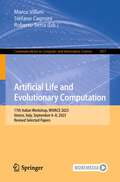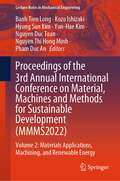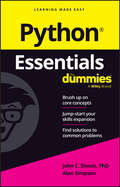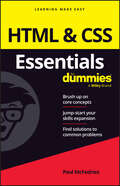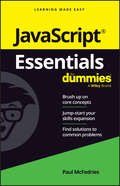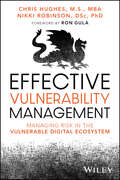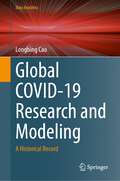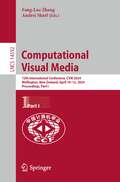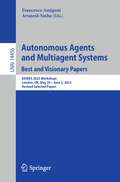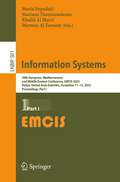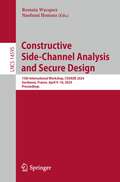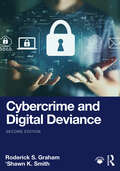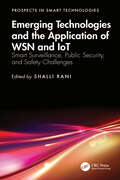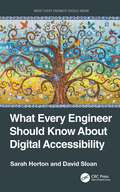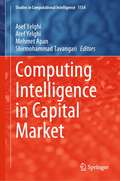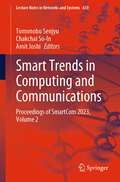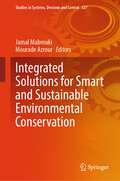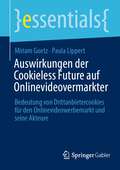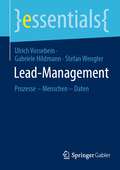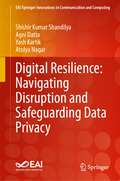- Table View
- List View
Artificial Life and Evolutionary Computation: 17th Italian Workshop, WIVACE 2023, Venice, Italy, September 6–8, 2023, Revised Selected Papers (Communications in Computer and Information Science #1977)
by Marco Villani Stefano Cagnoni Roberto SerraThis book constitutes the refereed post proceedings of the 17th Italian Workshop on Artificial Life and Evolutionary Computation, WIVACE 2023, held in Venice, Italy, during September 6–8, 2023.The 30 full papers included in this book were carefully reviewed and selected from 55 submissions. They were organized in topical sections as follows: Algorithms for complex systems, Biologically inspired models, Complex chemical systems, Adaptation and swarms, Learning, Medicine and Social systems.
Proceedings of the 3rd Annual International Conference on Material, Machines and Methods for Sustainable Development: Volume 2: Materials Applications, Machining, and Renewable Energy (Lecture Notes in Mechanical Engineering)
by Banh Tien Long Kozo Ishizaki Hyung Sun Kim Yun-Hae Kim Nguyen Duc Toan Nguyen Thi Hong Minh Pham Duc AnThis book presents selected, peer-reviewed proceedings of the 3rd International Conference on Material, Machines and Methods for Sustainable Development (MMMS2022), held in the city of Can Tho, Vietnam, from 10 to 13 November 2022. The purpose of the conference is to explore and ensure an understanding of the critical aspects contributing to sustainable development with a focus on advanced mechanical engineering, automation, materials, machines and methods. The contributions published in this book come from authors representing universities, research institutes and industrial companies and reflect the results of a very broad spectrum of research, from micro- and nanoscale materials design and processing, to mechanical engineering technology in industry. Many of the contributions selected for these proceedings focus on materials modeling, eco-material processes and mechanical manufacturing. Volume 2 of this book focuses on topics dedicated to materials applications, machining, and renewable energy. Selected topics include: material machinability and economic efficiency, sustainable development manufacturing technology, environmental protection, as well as green development and climate change prevention.
Python Essentials For Dummies
by John C. Shovic Alan SimpsonThe no-nonsense way to get started coding in the Python programming language Python Essentials For Dummies is a quick reference to all the core concepts in Python, the multifaceted general-purpose language used for everything from building websites to creating apps. This book gets right to the point, with no excess review, wordy explanations, or fluff, making it perfect as a desk reference on the job or as a brush-up as you expand your skills in related areas. Focusing on just the essential topics you need to know to brush up or level up your Python skill, this is the reliable little book you can always turn to for answers. Get a quick and thorough intro to the basic concepts of coding in Python Review what you've already learned or pick up essential new skills Create websites, software, machine learning, and automation for school or work Keep this concise reference book handy for jogging your memory as you code This portable Dummies Essentials book focuses on the key topics you need to know about the popular Python language. Great for supplementing a course, reviewing for a certification, or staying knowledgeable on the job.
HTML & CSS Essentials For Dummies
by Paul McFedriesThe easy way to brush up on your HTML & CSS programming skills HTML & CSS Essentials For Dummies is your quick and handy reference to all the core concepts of HTML & CSS—the must-know markup and style languages that make the internet go. This no-nonsense book gets right to the point, eliminating review material, wordy explanations, and fluff. Understand all the fundamentals of HTML and CSS, quickly. Perfect for a brush-up on the basics or as an everyday desk reference on the job, this is the reliable little book you can always turn to for answers. Get simple explanations of the basic concepts of coding with HTML & CSS Review what you've already learned or pick up essential new skills Create attractive and functional front ends for websites of all kinds Keep this concise reference book handy for jogging your memory as you work This book is clear and direct, focusing on the key topics you need to know about defining a website's user interface. Great for supplementing classroom learning, reviewing for a certification, or staying knowledgeable on the job.
JavaScript Essentials For Dummies
by Paul McFedriesThe concise and digestible get-started guide to JavaScript programming JavaScript Essentials For Dummies is your quick reference to all the core concepts about JavaScript—the dynamic scripting language that is often the final step in creating powerful websites. This no-nonsense book gets right to the point, eliminating review material, wordy explanations, and fluff. Find out all you need to know about the foundations of JavaScript, swiftly and crystal clear. Perfect for a brush-up on the basics or as an everyday desk reference on the job, this is the reliable little book you can always turn to for answers. Get a quick and thorough intro to the basic concepts of coding with JavaScript Review what you've already learned or pick up essential new skills Add interactive features to websites with JavaScript programming Keep this concise reference book handy for jogging your memory as you work This book is to the point, focusing on the key topics you need to know about this popular programming language. Great for supplementing classroom learning, reviewing for a certification, or staying knowledgeable on the job.
Effective Vulnerability Management: Managing Risk in the Vulnerable Digital Ecosystem
by Chris Hughes Nikki RobinsonInfuse efficiency into risk mitigation practices by optimizing resource use with the latest best practices in vulnerability management Organizations spend tremendous time and resources addressing vulnerabilities to their technology, software, and organizations. But are those time and resources well spent? Often, the answer is no, because we rely on outdated practices and inefficient, scattershot approaches. Effective Vulnerability Management takes a fresh look at a core component of cybersecurity, revealing the practices, processes, and tools that can enable today's organizations to mitigate risk efficiently and expediently in the era of Cloud, DevSecOps and Zero Trust. Every organization now relies on third-party software and services, ever-changing cloud technologies, and business practices that introduce tremendous potential for risk, requiring constant vigilance. It's more crucial than ever for organizations to successfully minimize the risk to the rest of the organization's success. This book describes the assessment, planning, monitoring, and resource allocation tasks each company must undertake for successful vulnerability management. And it enables readers to do away with unnecessary steps, streamlining the process of securing organizational data and operations. It also covers key emerging domains such as software supply chain security and human factors in cybersecurity. Learn the important difference between asset management, patch management, and vulnerability management and how they need to function cohesively Build a real-time understanding of risk through secure configuration and continuous monitoring Implement best practices like vulnerability scoring, prioritization and design interactions to reduce risks from human psychology and behaviors Discover new types of attacks like vulnerability chaining, and find out how to secure your assets against them Effective Vulnerability Management is a new and essential volume for executives, risk program leaders, engineers, systems administrators, and anyone involved in managing systems and software in our modern digitally-driven society.
Global COVID-19 Research and Modeling: A Historical Record (Data Analytics)
by Longbing CaoThis book provides answers to fundamental and challenging questions regarding the global response to COVID-19. It creates a historical record of COVID-19 research conducted over the four years of the pandemic, with a focus on how researchers have responded, quantified, and modeled COVID-19 problems. Since mid-2021, we have diligently monitored and analyzed global scientific efforts in tackling COVID-19. Our comprehensive global endeavor involves collecting, processing, analyzing, and discovering COVID-19 related scientific literature in English since January 2020. This provides insights into how scientists across disciplines and almost every country and regions have fought against COVID-19. Additionally, we explore the quantification of COVID-19 problems and impacts through mathematics, AI, machine learning, data science, epidemiology, and domain knowledge. The book reports findings on publication quantities, impacts, collaborations, and correlations with the economy and infectionsglobally, regionally, and country-wide. These results represent the first and only holistic and systematic studies aimed at scientifically understanding, quantifying, and containing the pandemic. We hope this comprehensive analysis will contribute to better preparedness, response, and management of future emergencies and inspire further research in infectious diseases. The book also serves as a valuable resource for research policy, funding management authorities, researchers, policy makers, and funding bodies involved in infectious disease management, public health, and emergency resilience.
Computational Visual Media: 12th International Conference, CVM 2024, Wellington, New Zealand, April 10–12, 2024, Proceedings, Part I (Lecture Notes in Computer Science #14592)
by Fang-Lue Zhang Andrei SharfThis book constitutes the refereed proceedings of CVM 2024, the 12th International Conference on Computational Visual Media, held in Wellington, New Zealand, in April 2024.The 34 full papers were carefully reviewed and selected from 212 submissions. The papers are organized in topical sections as follows:Part I: Reconstruction and Modelling, Point Cloud, Rendering and Animation, User Interations.Part II: Facial Images, Image Generation and Enhancement, Image Understanding, Stylization, Vision Meets Graphics.
Autonomous Agents and Multiagent Systems. Best and Visionary Papers: AAMAS 2023 Workshops, London, UK, May 29 –June 2, 2023, Revised Selected Papers (Lecture Notes in Computer Science #14456)
by Francesco Amigoni Arunesh SinhaThis book contains visionary and best papers from the workshops held at the International Conference on Autonomous Agents and Multiagent Systems, AAMAS 2023, held in London, UK, during May 29–June 2, 2023.The 12 regular papers, 5 best papers and 7 visionary papers, presented were carefully reviewed and selected from a total of more than 110 contributions to the workshops. They focus on emerging topics and new trends in the area of autonomous agents and multiagent systems and stem from the following workshops:- Workshop on Autonomous Robots and Multirobot Systems (ARMS)- Workshop on Adaptive and Learning Agents (ALA)- Workshop on Interdisciplinary Design of Emotion Sensitive Agents (IDEA)- Workshop on Rebellion and Disobedience in Artificial Intelligence (RaD-AI)- Workshop on Neuro-symbolic AI for Agent and Multi-Agent Systems (NeSyMAS)- Workshop on Multiagent Sequential Decision Making under Uncertainty (MSDM)- Workshop on Citizen-Centric Multi-Agent Systems (C-MAS)
Information Systems: 20th European, Mediterranean, and Middle Eastern Conference, EMCIS 2023, Dubai, United Arab Emirates, December 11-12, 2023, Proceedings, Part I (Lecture Notes in Business Information Processing #501)
by Maria Papadaki Marinos Themistocleous Khalid Al Marri Marwan Al ZarouniThis book constitutes selected papers from the 20th European, Mediterranean, and Middle Eastern Conference, EMCIS 2023, which was held in Dubai, UAE, during December 11-12, 2023. EMCIS covers technical, organizational, business, and social issues in the application of information technology and is dedicated to the definition and establishment of Information Systems (IS) as a discipline of high impact for IS professionals and practitioners. It focuses on approaches that facilitate the identification of innovative research of significant relevance to the IS discipline following sound research methodologies that lead to results of measurable impact. The 43 papers presented in this volume were carefully reviewed and selected from a total of 126 submissions. They were organized in topical sections as follows: Part I: Metaverse; blockchain technology and applications; digital governance; healthcare information systems; artificial intelligence; Part II: Big data and analytics; digital services and social media; innovative research projects; managing information systems; smart cities.
Social Media für Introvertierte: Erfolgreich sichtbar als leiser Unternehmer
by Tanja BernsauDieses Buch richtet sich an introvertierte Selbstständige, Solopreneure und Unternehmer und zeigt auf, wie sie Social Media auf die eigene, leise Art für Vertrieb und Marketing zu ihrem Vorteil nutzen können. Denn: Introvertierte Menschen haben zahlreiche verborgene Stärken, die ihnen besonders im Verkauf zugute kommen können. Diese gilt es zu entfalten!Die Autorin, selbst ein „leiser“ Mensch, räumt mit Mythen und Vorurteilen auf, präsentiert eine Vielzahl von praktischen Orientierungshilfen und Strategien für eine wirksame Positionierung auf Social Media. Am Beispiel der für Unternehmer wichtigsten Plattform LinkedIn zeigt sie auf, wie u. a. Social Selling, Social Listening, Content Marketing oder Personal Branding funktionieren – und mit welchen Kniffen sich introvertierte Menschen selbst aus dem Schneckenhaus locken.
Constructive Side-Channel Analysis and Secure Design: 15th International Workshop, COSADE 2024, Gardanne, France, April 9–10, 2024, Proceedings (Lecture Notes in Computer Science #14595)
by Romain WacquezThis book constitutes the refereed proceedings of the 15th International Workshop on Constructive Side-Channel Analysis and Secure Design, COSADE 2024, held in Gardanne, France, during April 9–10, 2024. The 14 full papers included in this book were carefully reviewed and selected from 42 submissions. They were organized in topical sections as follows: Analyses and Tools; Attack Methods; Deep-Learning-Based Side-Channel Attacks; PUF/RNG; and Cryptographic Implementations.
Cybercrime and Digital Deviance
by Roderick S. Graham 'Shawn K. SmithCybercrime and Digital Deviance, Second Edition, combines insights from sociology, criminology, psychology, and cybersecurity to explore cybercrimes such as hacking, identity theft, and romance scams, along with forms of digital deviance such as pornography addiction, trolling, and “canceling” people for perceived violations of norms.Other issues are explored including cybercrime investigations, nation-state cybercrime, the use of algorithms in policing, cybervictimization, and expanded discussion of the theories used to explain cybercrime. Graham and Smith conceptualize the online space as a distinct environment for social interaction, framing their work with assumptions informed by their respective work in urban sociology and spatial criminology, and offering an engaging entry point for understanding what may appear to be a technologically complex course of study. The authors apply a modified version of a typology developed by David Wall: cybertrespass, cyberfraud, cyberviolence, and cyberpornography. This typology is simple enough for students just beginning their inquiry into cybercrime, while its use of legal categories of trespassing, fraud, violent crimes against persons, and moral transgressions provides a solid foundation for deeper study. In this edition each chapter includes a new “Current Events and Critical Thinking” section, using concepts from the chapter to explore a specific event or topic like the effect of disinformation on social cohesion and politics.Taken together, Graham and Smith’s application of a digital environment and Wall’s cybercrime typology makes this an ideal upper-level text for students in sociology and criminal justice. It is also an ideal introductory text for students within the emerging disciplines of cybercrime and cybersecurity.
Cybercrime and Digital Deviance
by Roderick S. Graham 'Shawn K. SmithCybercrime and Digital Deviance, Second Edition, combines insights from sociology, criminology, psychology, and cybersecurity to explore cybercrimes such as hacking, identity theft, and romance scams, along with forms of digital deviance such as pornography addiction, trolling, and “canceling” people for perceived violations of norms.Other issues are explored including cybercrime investigations, nation-state cybercrime, the use of algorithms in policing, cybervictimization, and expanded discussion of the theories used to explain cybercrime. Graham and Smith conceptualize the online space as a distinct environment for social interaction, framing their work with assumptions informed by their respective work in urban sociology and spatial criminology, and offering an engaging entry point for understanding what may appear to be a technologically complex course of study. The authors apply a modified version of a typology developed by David Wall: cybertrespass, cyberfraud, cyberviolence, and cyberpornography. This typology is simple enough for students just beginning their inquiry into cybercrime, while its use of legal categories of trespassing, fraud, violent crimes against persons, and moral transgressions provides a solid foundation for deeper study. In this edition each chapter includes a new “Current Events and Critical Thinking” section, using concepts from the chapter to explore a specific event or topic like the effect of disinformation on social cohesion and politics.Taken together, Graham and Smith’s application of a digital environment and Wall’s cybercrime typology makes this an ideal upper-level text for students in sociology and criminal justice. It is also an ideal introductory text for students within the emerging disciplines of cybercrime and cybersecurity.
Emerging Technologies and the Application of WSN and IoT: Smart Surveillance, Public Security, and Safety Challenges (Prospects in Smart Technologies)
by Shalli RaniThe Internet of Things (IoT) has numerous applications, including smart cities, industries, cloud-based apps, smart homes, and surveillance.The Internet of Things (IoT) enables smarter living by connecting devices, people, and objects. As networking became a crucial aspect of the Internet, rigorous design analysis led to the development of new research areas.The Internet of Things has revolutionized daily living in countless ways. It enables communication between buildings, people, portable gadgets, and vehicles, facilitating mobility. Smart cities and cloud-based data have transformed corporate practices. With billions of connected gadgets, everything will soon be able to communicate remotely. IoT networks, whether public or private, rely significantly on machine learning and software-defined networking. Indian and other governments have approved various research projects on IoT-based networking technologies. This field of study will significantly impact society in the future.Researchers are concerned about the many application areas and driving forces behind smart cities. The authors aim to provide insights into software-defined networking, artificial intelligence, and machine learning technologies used in IoT and networking. The framework focuses on practical applications and infrastructures. The book includes practical challenges, case studies, innovative concepts, and other factors that impact the development of realistic scenarios for smart surveillance. It also highlights innovative technology, designs, and algorithms that can accelerate the creation of smart city concepts.This resource includes real-world applications and case studies for smart city technology, enormous data management, and machine learning prediction, all with confidentiality and safety problems.
Emerging Technologies and the Application of WSN and IoT: Smart Surveillance, Public Security, and Safety Challenges (Prospects in Smart Technologies)
The Internet of Things (IoT) has numerous applications, including smart cities, industries, cloud-based apps, smart homes, and surveillance.The Internet of Things (IoT) enables smarter living by connecting devices, people, and objects. As networking became a crucial aspect of the Internet, rigorous design analysis led to the development of new research areas.The Internet of Things has revolutionized daily living in countless ways. It enables communication between buildings, people, portable gadgets, and vehicles, facilitating mobility. Smart cities and cloud-based data have transformed corporate practices. With billions of connected gadgets, everything will soon be able to communicate remotely. IoT networks, whether public or private, rely significantly on machine learning and software-defined networking. Indian and other governments have approved various research projects on IoT-based networking technologies. This field of study will significantly impact society in the future.Researchers are concerned about the many application areas and driving forces behind smart cities. The authors aim to provide insights into software-defined networking, artificial intelligence, and machine learning technologies used in IoT and networking. The framework focuses on practical applications and infrastructures. The book includes practical challenges, case studies, innovative concepts, and other factors that impact the development of realistic scenarios for smart surveillance. It also highlights innovative technology, designs, and algorithms that can accelerate the creation of smart city concepts.This resource includes real-world applications and case studies for smart city technology, enormous data management, and machine learning prediction, all with confidentiality and safety problems.
What Every Engineer Should Know About Digital Accessibility (ISSN)
by Sarah Horton David SloanAccessibility is a core quality of digital products to be deliberately addressed throughout the development lifecycle. What Every Engineer Should Know About Digital Accessibility will prepare readers to integrate digital accessibility into their engineering practices. Readers will learn how to accurately frame accessibility as an engineering challenge so they are able to address the correct problems in the correct way.Illustrated with diverse perspectives from accessibility practitioners and advocates, this book describes how people with disabilities use technology, the nature of accessibility barriers in the digital world, and the role of engineers in breaking down those barriers. Accessibility competence for current, emerging, and future technologies is addressed through a combination of guiding principles, core attributes and requirements, and accessibility‑informed engineering practices.FEATURES Discusses how technology can support inclusion for people with disabilities and how rigorous engineering processes help create quality user experiences without introducing accessibility barriers Explains foundational principles and guidelines that build core competency in digital accessibility as they are applied across diverse and emerging technology platforms Highlights practical insights into how engineering teams can effectively address accessibility throughout the technology development lifecycle Uses international standards to define and measure accessibility quality Written to be accessible to non‑experts in the subject area, What Every Engineer Should Know About Digital Accessibility is aimed at students, professionals, and researchers in the field of software engineering.
What Every Engineer Should Know About Digital Accessibility (ISSN)
by Sarah Horton David SloanAccessibility is a core quality of digital products to be deliberately addressed throughout the development lifecycle. What Every Engineer Should Know About Digital Accessibility will prepare readers to integrate digital accessibility into their engineering practices. Readers will learn how to accurately frame accessibility as an engineering challenge so they are able to address the correct problems in the correct way.Illustrated with diverse perspectives from accessibility practitioners and advocates, this book describes how people with disabilities use technology, the nature of accessibility barriers in the digital world, and the role of engineers in breaking down those barriers. Accessibility competence for current, emerging, and future technologies is addressed through a combination of guiding principles, core attributes and requirements, and accessibility‑informed engineering practices.FEATURES Discusses how technology can support inclusion for people with disabilities and how rigorous engineering processes help create quality user experiences without introducing accessibility barriers Explains foundational principles and guidelines that build core competency in digital accessibility as they are applied across diverse and emerging technology platforms Highlights practical insights into how engineering teams can effectively address accessibility throughout the technology development lifecycle Uses international standards to define and measure accessibility quality Written to be accessible to non‑experts in the subject area, What Every Engineer Should Know About Digital Accessibility is aimed at students, professionals, and researchers in the field of software engineering.
Computing Intelligence in Capital Market (Studies in Computational Intelligence #1154)
by Asef Yelghi Aref Yelghi Mehmet Apan Shirmohammad TavangariThe book is divided into sections according to the content of the chapters. The first section covers AI concepts with NP and financial issues. The second section covers AI techniques in relation to Fintech issues. The remaining sections are implementation and analysis. As science and technology development and algorithms are widely used in various fields, their influence and development have increased efficiency and productivity. The introduction of algorithms in the financial field has not been an exception to this. In recent years, the growth and development of the financial system have been in sync with the growth of technology. Fintechs were born at the intersection of these two sectors. What happens through the application of computer knowledge in the financial field, or the examination of the efficiency and effectiveness of their use and the interaction and combination of these two fields has been written very infrequently in the majority of books. In Fintech, there are problems that researchers focus on such as customer support, portfolio management, trading algorithms, fraud detection, credit risk assessment, insurance, and wealth management. The mentioned problems are complex and are mapped to NP problems in the field of artificial intelligence. In the last two decades, optimization algorithms, neural networks, and deep learning have been widely applied in many scientific and engineering fields to solve the mentioned problems. The purpose of this book is to provide the reader with the most used artificial intelligence methods for scientific and engineering problems. This book is used by students, scientists, and practitioners in various fields. The chapters are self-explanatory, and the reader can read each one separately. They describe the algorithm used, the chosen problem, and the implementation. In addition, practical examples, comparisons, and experimental results are presented.
Smart Trends in Computing and Communications: Proceedings of SmartCom 2023, Volume 2 (Lecture Notes in Networks and Systems #650)
by Tomonobu Senjyu Chakchai So-In Amit JoshiThis book gathers high-quality papers presented at the Seventh International Conference on Smart Trends in Computing and Communications (SmartCom 2022), organized by Global Knowledge Research Foundation (GR Foundation) from January 24–25, 2023, in Jaipur, India. It covers the state-of-the-art and emerging topics in information, computer communications, and effective strategies for their use in engineering and managerial applications. It also explores and discusses the latest technological advances in, and future directions for, information and knowledge computing and its applications.
Integrated Solutions for Smart and Sustainable Environmental Conservation (Studies in Systems, Decision and Control #527)
by Jamal Mabrouki Mourade AzrourResource depletion and ecological risks are more than ever at the heart of societal and economic debates. In the 1970s, the developed countries saw the Fordist growth regime crumble in parallel with the growing awareness of the ecological issue. Since the first industrial revolutions, technological dynamics have been the cause of many environmental problems, and there is a consensus on the diagnosis. Integrated technologies reduce resource use and/or pollution at source by using cleaner production methods. This generally leads to a reduction in the by-products, energy inputs and resources used by companies to produce goods. Integrated production technologies reduce negative environmental impacts at source by substituting or modifying cleaner technologies. Examples of integrated, or cleaner, production technologies are the recirculation of materials, the use of environmentally friendly materials (such as the substitution of water for organic solvents), etc. However, the implementation of integrated production technologies is often hampered by obstacles related to cost, coordination and skill inertia problems and to the productive organisation of companies. In addition to the high investment costs of new integrated technologies, additional barriers may emerge depending on the nature of the environmental problem and the type of environmental regulation in question.
Auswirkungen der Cookieless Future auf Onlinevideovermarkter: Bedeutung von Drittanbietercookies für den Onlinevideowerbemarkt und seine Akteure (essentials)
by Miriam Goetz Paula LippertDrittanbietercookies ermöglichen Vermarktern eine fundierte Kampagnenanalyse und Zielgruppenbestimmung. Welche Auswirkungen hat der Wegfall von Cookies auf sie? Das essential beschreibt zunächst Cookies und deren aktuelle Einsatzfelder. Auf Basis von Experteninterviews mit Branchenkennern folgt dann ein Ausblick, welche Chancen und Risiken mit dem Wegfall der Cookies für die Vermarkterbranche und Endverbraucher einhergehen und welche Alternativen zu Drittanbietercookies existieren.
Lead-Management: Prozesse – Menschen – Daten (essentials)
by Ulrich Vossebein Gabriele Hildmann Stefan WenglerLead-Management ist eine der großen Herausforderungen im Vertrieb, da die Neukundengewinnung immer bedeutsamer wird. Dieses essential erläutert, wie durch den parallelen Ausbau der drei Basisdimensionen: Prozesse, Menschen und Daten Lead-Exzellenz erreicht werden kann. Hierzu sind zunächst die Rahmenbedingungen zu analysieren und zu bewerten. Anschließend müssen die Prozesse in eine Prozesslandkarte eingebunden, die Kompetenzprofile den neuen Anforderungen angepasst und die Datenbasis vervollständigt werden. Eine umfangreiche Checkliste zeigt auf, wie Unternehmen bei der Einführung oder Überarbeitung ihres bereits existierenden Lead-Managements sinnvollerweise vorgehen sollten.
Advances in Remanufacturing: Proceedings of the VII International Workshop on Autonomous Remanufacturing (Lecture Notes in Mechanical Engineering)
by Marcello Fera Mario Caterino Roberto Macchiaroli Duc Truong PhamThis book features the papers presented at IWAR 2023. The overall objective of the event was to bring together international scientists and engineers to bridge the academic and industrial worlds in the field of remanufacturing. Various themes related to remanufacturing, including methods for operations management, methodologies for quality assessment and life cycle assessment, the integration of robots in remanufacturing, and the use of modern I4.0 technologies in a remanufacturing context among others were addressed. This book is intended for academics, graduate students, researchers, as well as industrial practitioners engaged in the field of remanufacturing.
Digital Resilience: Navigating Disruption and Safeguarding Data Privacy (EAI/Springer Innovations in Communication and Computing)
by Shishir Kumar Shandilya Agni Datta Yash Kartik Atulya NagarThis book offers an in-depth overview of digital resilience, defined as the ability of individuals, organizations, and societies to adapt to and counter various digital threats such as cyberattacks, data breaches, and other forms of cyber threats. Digital resilience not only enables proactive measures but also ensures fault-tolerant planning and design. The book elaborates on the necessary techniques and methods to achieve digital resilience. Key methodologies, including quantum computing, post-quantum cryptography, nature-inspired cybersecurity, zero-trust systems, zero-knowledge proofs, multi-party computation, and the emerging field of space security, are discussed in detail. The book provides insights into artificial intelligence and machine learning, examining their impact on society and organizations. It critically analyses the role of cybersecurity in businesses, emphasizing its importance for safety and economic stability. In addition, the book discusses notable cyber incidents, offering valuable insights into digital resilience. It serves as a comprehensive compilation, featuring key terms, definitions, case studies, and references to existing literature and research in cybersecurity, analytics, information sciences, future computing, digital resilience, and related fields.
